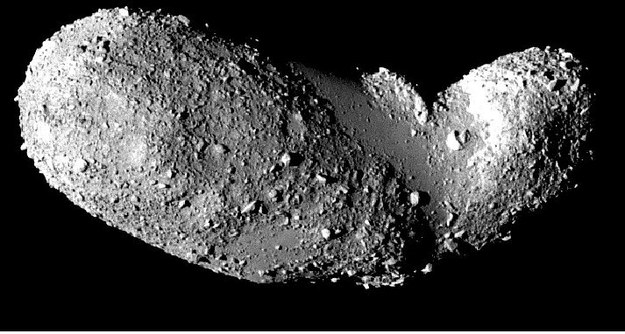Space weathering: geologists' journey to space
 The Itokawa asteroid is primarily composed of silicate rocks. Its surface is affected by space weathering. Photo by NASA.Popis
The Itokawa asteroid is primarily composed of silicate rocks. Its surface is affected by space weathering. Photo by NASA.Popis
The solar system abounds in tiny dust particles that are brought to its inner areas, mainly by comets and remnants of other smaller bodies. These particles move at ultra high speeds, hitting surfaces not protected by the atmosphere, as a result their kinetic energy quickly converts to heat and the particles evaporate. This constant process has some logical consequences. The bombardment of tiny particles dramatically changes the surface of space bodies, causing what planetary geologists call space weathering. The result of this weathering, however, looks a little different than that of the weathering process that takes place on the Earth's surface. The surface of space bodies is coated with "glass" which contains large quantities of iron nanoparticles whose diameter is less than 10 nanometres. This process leads to several modifications of the spectral signature: it darkens the bodies' surface (and thus reduces the albedo), reddens it (or brightens overall over longer wavelengths of light), and changes the characteristic peaks and troughs identifying the surface. Planetary geologists use spectra to identify the compositions of space bodies, therefore detailed research of the space weathering process is highly important.
In space this process takes place outside the atmosphere, and that needs to be simulated on earth conditions. A couple of FoS geologists, PhD student Matthew Markley and his tutor, Gunther Kletetschka of the Institute of Hydrogeology, Engineering Geology and Applied Geophysics, recently picked up this task and then described the results of their explorations in the April issue of Icarus. Markley clarifies that “Our paper is split into two sections, one part done at the Hawaii Institute of Geophysics and Planetology, was the laser simulation of dust particles hitting surfaces of planets, and the other part, magnetic measurements were done in the Faculty of Science in Charles University.”
 Example of space weathering characterised by darkening and reddening of body surfaces. The material in the middle is a sample of powdered olivine after laser irradiation. The three pads around the sample are light reflectivity standards - the lightest one represents 50%, the darkest one 99% and the third one 80% of reflected light. Photo by M.M.MarkleyPopis
Example of space weathering characterised by darkening and reddening of body surfaces. The material in the middle is a sample of powdered olivine after laser irradiation. The three pads around the sample are light reflectivity standards - the lightest one represents 50%, the darkest one 99% and the third one 80% of reflected light. Photo by M.M.MarkleyPopis
Space weathering can be simulated in several ways. One of them is to use laser impulses. The greatest benefit of this method is that the strength of the laser beam is adjustable, i.e. it is possible to accurately set the energy of the impulse to correspond with that of micrometeorite impacts, and it is highly repeatable. “The impact of the energised beam triggers off a melting process in the target material, in our case olivine (common mineral in minor bodies in the solar system). As the conditions in the various parts of the solar system are roughly known, we applied three different energies to the samples to correspond with space weathering on Mercury, the Moon and asteroid belt bodies,” explains Kletetschka. The researchers also wanted to know how the surface of the mineral changes in terms of magnetic properties. Since iron is a highly magnetic material, the tiny nanoparticles of iron are what is called superparamagnetic. As a result of their size, their magnetic properties are different from that of larger particles. The equipment in the FoS labs made it possible to measure the properties of laser-modified surfaces internally, i.e. in premises of the Faculty of Science (Charles University).
This simulated space environment offered a number of interesting scientific avenues for the future. “Primarily, we can use these results to identify the age of surfaces of space bodies. The more eroded the surface is due to space weathering, the older it is. Another possible use of the results is based on the conclusion that magnetic effects cause spectral changes. If this effect is mapped out precisely, we will also be able to produce magnetic maps of bodies remotely," explains Kletetschka.

Although it may seem fairly unimportant, our ability to "read" the magnetic field of distant asteroids poses many interesting opportunities. First of all, it can tell us a lot about how the magnetic field originates and fades away. Many questions in this area are still unanswered, included questions relating to Earth. Moreover, this glimpse of the space may have another interesting outcome. The magnetic field also protects the body, and not only against space weathering, but also against negative impacts of various types of radiation. It is exactly this effect that led to the origin of life on Earth - without this effect many organic molecules vital for the origin and maintenance of life would be killed by such radiation.
Some of the most frequently explored bodies include the Vesta and Itokawa asteroids that have been analysed, directly in space, by the Dawn and Hayabusa probes, respectively. These space bodies have their magnetic fields, but we still do not know how these magnetic fields originated. “Bodies like these may contain organic compounds vital for the origin of life. By identifying the structure and origin of their magnetism, we can decide whether or not they can be the place where life originated," concludes Günther Kletetschka.
By Michal Andrle
Introductory photo: Asteroid Vesta and Dawn Spaceprobe
Image credit: NASA/JPL-Caltech
Document Actions